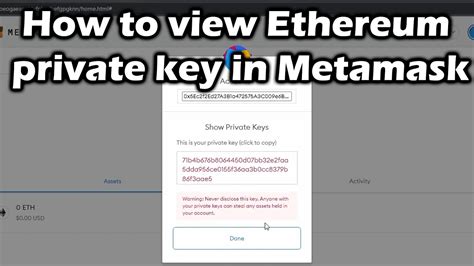Ethereum: separation of the facts from fiction – Understanding of wallets and private keys
While the world of cryptocurrency continues to evolve, it is not uncommon for beginners to have questions about how to manage their digital resources. A common misunderstanding is that everything you need to do is store your funds in a single portfolio and the associated private key. However, this simplification is missing the complexity of the underlying technology of Ethereum.
In this article, we will deepen the world of wallets and private keys, exploring what they are actually, how they are used and why it is essential to understand their role in guaranteeing your digital resources.
What is a wallet?
A wallet is a software program or a hardware device that stores and manages cryptocurrency resources. Generally it consists of:
- Private key

: a unique code that unlocks the wallet and allows you to access your funds.
- Public address : an string of univocal characters (also known as “address”) that can be used to receive funds.
Can I simply use a single address and a private key?
While it might seem like a simple solution, the use of a single address and a private key for all transactions is not recommended. That’s why:
* Safety risks : If someone has your private key, it will have access to all your funds. This is known as “theft of private key” or “key theft”.
* Return attacks : If you use a single address, it can be vulnerable to the re -entry attacks, which allow the attackers to repeatedly call transactions on the same public address without being paid.
* Centralized control : the use of a single address and a private key creates a centralized control point for funds. This makes it easier for harmful actors to manipulate or exploit your resources.
What is the role of a portfolio manager?
A portfolio manager (also known as “portfolio supplier”) acts as an intermediary between the user, the user and the blockchain network below. Manage tasks such as:
* Key management : management of private keys, create new ones and memorize them safely.
* COPING OF THE ADDITION : Creation of unique addresses from public keys.
* Taxation of transactions : verification of transactions on the blockchain network.
And phrases of seeds or mnemonic codes?
The seed phrases or mnemonic codes are not directly related to portfolios or private keys. Are used for:
* Key recovery : in the event that it loses access to the private key, a seed phrase can be used to recover it.
* Organization and storage space : seed phrases can be used to archive more private keys.
Conclusion
In conclusion, while it might seem simple to use only one address and a private key for all transactions, this approach is not safe or reliable. A portfolio manager provides an additional level of security and control by managing private keys, creating unique addresses and validating transactions on the blockchain network. If you are interested in learning more about Ethereum and cryptocurrency portfolios, we recommend that you explore the following resources:
* Ethereum.org
: the official website for Ethereum has a complete section on portfolios and private keys.
* Cryptocurrency forum : Online communities such as Reddit’s cryptocurrency can provide valuable insights from expert users.
By understanding the complexities of wallets and private keys, you will be better equipped to manage your digital resources safely.


